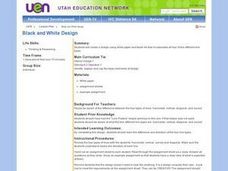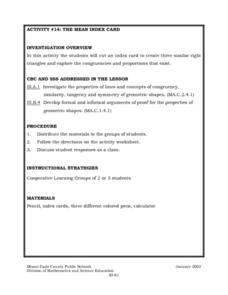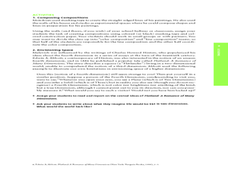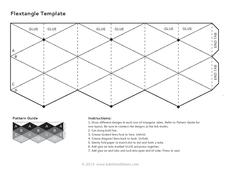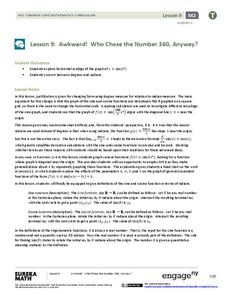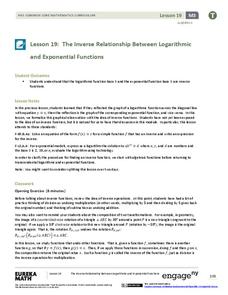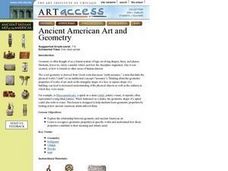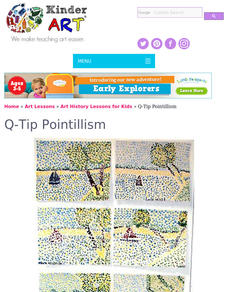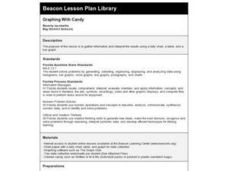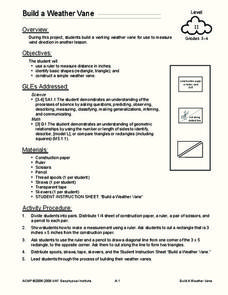Curated OER
The Quadrilateral Family
In this quadrilaterals worksheet, 10th graders solve and complete 10 different problems that include identifying various quadrilaterals. First, they indicate whether the statements are true or false for each. Then, students determine the...
Curated OER
Black and White Design
Students are introduced to the four different types of lines. After explaining the basic elements of design, they create their own artwork using white paper and black ink incorporating the different types of lines. To end the lesson,...
Curated OER
What Makes You Scream?
Eighth graders study Edvard Munch's painting "The Scream." They produce their own scream using directional lines as Munch did. Line was used by Munch in a variety of directions(horizontal, vertical and diagonal.
Curated OER
Boarding of Symmetrical Shapes
Second graders use geoboards to model polygons and to practice finding lines of symmetry.
Curated OER
Values and Composition
Students examine and analyze the values of gray and the composition in photographs by Ansel Adams. They discuss elements of art, draw shapes and lines, complete a tone rectangle, and create a still life drawing.
Curated OER
THE MEAN INDEX CARD
Students cut an index card to create three similar right triangles and explore the congruencies and proportions that exist. They investigate the properties of lines and concepts of congruency, similarity, tangency and symmetry of...
Curated OER
New Visions of the World
Students explore the art of Kazimir Malevich and Piet Mondrian as an analysis of abstract painting. In this abstract painting lesson, students explore the painting style of the two artists. Students analyze the use of shape, line,...
Curated OER
Tracing Practice
In this pre-printing practice worksheet, students trace a set of straight lines from top to bottom, both on a picture of a kite and at the bottom of the page, then color. Page has multiple links to additional resources.
Babble Dabble Do
Flextangle Template
Flexagons? What a great way to play with geometry. Kids use the provided template to transform a plain G sheet into a solid G paper toy. The resource even comes with an instructional video and illustrations.
Primary Resources
Coordinate Pairs: An Introduction
Ordered pairs, the x and y-axis - sounds like it's time to introduce learners to the plotting points on a graph! This presentation is great as it introduces the concept, provides an example of how to use a coordinate plane, and then...
BBC
Simple Addition and Subtraction
Here is a wonderful lesson designed for young mathematicians. In it, they employ simple addition and subtraction strategies in order to solve word problems. There are some excellent activity sheets embedded in the plan to make the...
EngageNY
Awkward! Who Chose the Number 360, Anyway?
Don't give your classes the third degree. Use radians instead! While working with degrees, learners find that they are not efficient and explore radians as an alternative. They convert between the two measures and use radians with the...
EngageNY
The Inverse Relationship Between Logarithmic and Exponential Functions
Introducing inverse functions! The 20th installment of a 35-part lesson encourages scholars to learn the definition of inverse functions and how to find them. The lesson considers all types of functions, not just exponential and...
Curated OER
Table Mazes Using Microsoft Word
Young scholars use the table feature of Microsoft Word to construct a solvable maze. They incorporate clip art and WordArt into their mazes. Students create a table and use word processing functions to design a maze. They create...
Curated OER
Ancient American Art and Geometry
Students explore the relationship between geometry and ancient American art. They see how to recognize geometric properties in specific works and explain how these properties contribute to their meaning and artistic merit.
Curated OER
Timber Rattlesnake
A wonderful way for student to learn about snakes common to Florida. Pictures, diagrams and definitions accompany scientific details and comparisons to other snakes
Curated OER
Family at Home
Students fold paper to form a house, then use three numbers to make fact families for their houses. They write a family of multiplication and division facts on a piece of paper cut in the shape of a house.
Curated OER
Blast It! (Learning About Copper)
Opening with background information on copper use and mining, this worksheet assesses junior geologists' reading comprehension. A map activity is available, but the map is not. There is a useful set of vocabulary matching cards and a...
Curated OER
MONET'S GARDEN BY THE SEA
Middle schoolers establish their own design utilizing a similar composition to Monet's, integrate their drawing skills in creating a "garden by the sea."
Curated OER
Why are Electrons Important?
Students write electron configuration of elements using atomic numbers and they identify valence electrons. In this electrons lesson plan, students observe a demonstration showing the space-filling property of an electron. They also...
Texas Instruments
The Determinant of a Matrix
Students calculate the determinant. In this algebra lesson, students find the determinant and use to calculate the area of a triangle. They calculate the area of a quadrilateral in a plane.
Curated OER
Q-tip® Pointillism
Young scholars create paintings in the style of art known as pointillism.
Curated OER
Graphing With Candy
Students gather information and interpret the results using a tally chart, a table, and a bar graph.
Curated OER
Build a Weather Vane
Third graders measure wind direction. In this weather lesson, 3rd graders build a weather vane from a straw, skewer, spool, and flag. Students measure wind direction using their weather vane.



